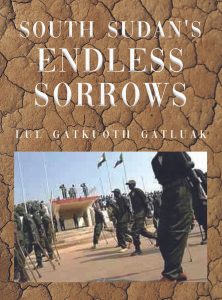The purpose of this message is to announce South Sudan’s Endless Sorrows.; a text authored by this writer. The theme of South Sudan’s Endless Sorrows is to address South Sudan’s long bitter road to freedom, failures after two years in independence, trials, tribulations, and the perilous destruction the South Sudanese people had gone through since the inception of the Sudan.
For instance, the sorrow of South Sudanese and other indigenous African people in Sudan started when the Arab people crossed the Red Sea through Egypt and later penetrated into Sudan in the twelfth century. Arab’s first sorrowful mistreatment to African natives was to make them serve as domestic servants, concubines, and soldiers in the Pharaoh’s army (Collins, 1971).
This unbearable, growing human rights violation had worsened in 1820 after the centuries of exploitation and slave-raiding by Turkish-Egyptians, followed by the British and Egyptians’ imperialist colonial occupation in the nineteenth century, the Arab rekindle mistreatment after the later grabbed Sudan power from British colonial power in 1956.
All these mentioned sorrowful actions of mistreatment have caused enormously South Sudanese life but only sorrow, and what is still life threatening is tribalism among South Sudanese people. Reality shows this sorrow will never end soon given deep rooted hatred. All these misfortunes are going to be explored in this study.
The journey of a thousand miles, we are told, begins with a single step ahead. This book is one’s first step to dive deep into South Sudan/Sudan historical records. The aim of South Sudan’s Endless Sorrows is to provide explicit historical facts about South Sudan. It is a researched text that has uprooted and explored past and present events regarding South Sudan. The main theme of the book is to address South Sudan’s long, bitter road to freedom and the miserable failure after two years of independence.
All information in the book comes from following sources:
- summary of the books and articles the author had read about Sudan and South Sudan.
- interviews the author had conducted with individuals, particularly those former commanders who have been in the SPLM/SPLA since its inception in 1983 or early on,
- one’s own personal experiences as a young man growing up in a village close to Bilpam and Itang, the birthplaces of the second and the third movements when senior politicians from the Southern Sudan had defected in 1975 and 1983 respectively
When the author says the second and the third movements, he means the Anyanya II and the SPLM/A, beside the first movement, the Anyanya I, that was hatched on August 18, 1955 in the town of Torit in Equatoria region. Oftentimes, some South Sudanese referred to South Sudan liberation movements as only Anyanya I and the SPLM/A without including Anyanya II.
This author believes the notion is biased or a strategic error that needs to be straightened and corrected, given the fact that the liberation struggle for South Sudan freedom did not start with Anyanya I and then jumped to SPLM/A in 1983.
Anyanya II was in the middle, which means SPLM/A has the DNA of both Anyanya I and Anyanya II. In this case, there is no reason history should not be rewritten referring to the South Sudan liberation struggles as three separate movements: the Anyaya I, Anyanya II and the SPLM/A. To this author, SPLM/SPLA was an extension of the two mentioned previous movements.
The interviews the author has conducted are based on one-on-one interaction. Sometimes face to face or through the phone and electronic mailing system, especially social media. In most cases, the author used the information informants had provided and avoided identifying informant identification, unless individuals agreed to reveal their identity.
Nevertheless, there are many icons and high-profile individuals whose identities are automatically revealed. The reason is that one does not have any other way to disclose or channel information about these public servants, despite the fact that they are the ones shaping South Sudan’s history.
Profoundly, the author spent a very long time researching materials and attempted, as best as he could, to provide positive historical facts pertaining South Sudan. His purpose is to recount chronological push factors and the suffering South Sudanese people had gone through from the hand of external intruders or on their own hand, like the current unrest that had devastated the nation since 2013.
Although the author feels like he eloquently extracted a large amount of details about South Sudan’s history from previous and current documents, there still might be more important themes he has not addressed.Therefore, the author leaves it up to the reader to further explore some of the essential uncovered historical facts about South Sudan and make them known to all people.
In summation, the author would like to apologize in advance to South Sudanese people whose names are used in this book, especially when the author expresses his viewpoints on issues that might wrong the subject or individuals. The reason is that it is not easy to objectively explain a situation without supporting one side of the history and opposing the other side.
Many readers may find the author’s judgment to be too critical to some extent, but that is because he does not have any other possible way to give an explanation that would not criticize your part of the history. This note is an appeal to all people who may disagree with one interpretation of issues that are facing us as a society then and now.
This book is dedicated to 2.5 million, mostly South Sudanese people, who had perished as the result of the struggle for South Sudan freedom, and all men, women, and children who unjustifiably had been killed by our own government since 2013 and into the present, including those who lost limbs in both the revolutionary war and South Sudan’s internal, aimless civil war.
To all widows and widowers who have lost loved ones and live painful lives after their partners have been discriminately killed or died as the result of hunger and disease. To all orphans who lost their parents and grew up without knowing their biological fathers and mothers; all they hear is that “you resemble your dad or mom” from those who knew the parents when they were alive.
No pictorial images of the parents to view because during the war, it was impossible for the majority of people to carry cameras that could help them take pictures. No other important documents like identification cards, school certificates, and/or passports. For those who try to keep family photo albums, whenever the enemy attacks a town, village, or camp you live in at night, you do not have a moment to pack your valuable belongings—all you do is just run to save your life.
If you try to come back after an attack had ended and the enemy had retreated, you will only find burning ashes, given the fact that all properties had already been set on fire. Yet, the book is still dedicated to all South Sudanese Diasporas who have scattered all over the world looking for safe places to live.
The majority of these escapees were separated from their parents at a very young age. They have lived all their adolescent lives without close relatives around. Many of them did not make it to those promised safe places. Some died along the road. All of them were faced with all kinds of earthly tribulations. They all are experts of pain who have been subjected to pain themselves by the powerful elites and all earthly predators.
They all are experts of hunger, who have been hungry for so long, and eat undressed leaves and remain sullen for the day waiting empty for the next day. Finally, and yet importantly, they all are experts of need, having been needy themselves.
In summary, the book has 30 chapters, 58 sub-chapters and 534 pages. It was published in December 2023 by Dorrance publishing company. The book title entices the reader with four thought provoking words and our hero images when they were matching during South Sudan independence proclamation on July 9, 2011.
It has been dedicated to 2.5 million, mostly South Sudanese people, who had perished as the result of the struggle for South Sudan freedom, and all men, women, and children who unjustifiably had been killed by our own government since 2013 and into the present, including those who lost limbs in both the revolutionary war and South Sudan’s internal, aimless civil war.
It is also dedicated to all widows and widowers who have lost loved ones and live painful lives after their partners have been discriminately killed or died as the result of hunger and disease. I strongly recommend this book.
It is now available in many online libraries, including the publisher-Dorrance Publishing Company, Amazon, Barnes & Noble, and many other libraries around the globe. If you are unacquaintance, you can simply google my name and the image may pop up on your screen. Moreover, I encourage all readers to review the book once individuals have had a chance to read the book. Thank you very much in advance!
Respectively:
Lul Gatkuoth Gatluak
Lul should be reach @lu**********@***il.com


















